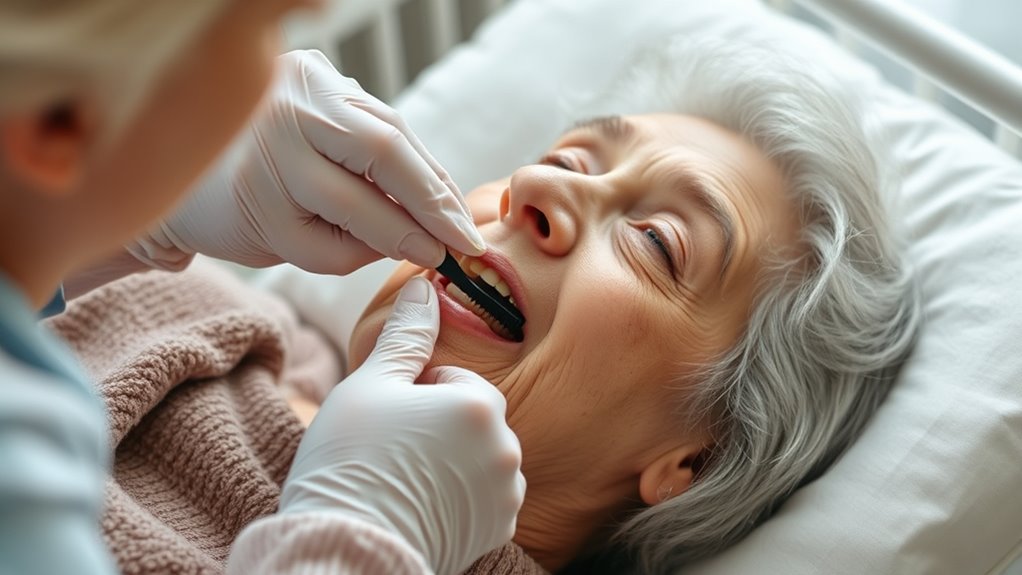To care for a bed-bound Alzheimer’s patient, establish a gentle, consistent oral hygiene routine twice daily using soft-bristled tools and mild products. Assess their needs regularly, support comfort by keeping their head elevated, and watch for signs of swallowing issues or infections. Adjust techniques based on cooperation, using calming communication and appropriate products to prevent discomfort. With tailored steps and ongoing professional support, you can markedly improve their oral health—more essential tips await you.
Key Takeaways
- Conduct regular oral assessments to identify specific needs and risks, including decay, gum inflammation, and swallowing difficulties.
- Establish a consistent routine with gentle brushing twice daily using soft tools, supported by calming communication and proper positioning.
- Use tailored products like fluoride toothpaste, alcohol-free mouth rinses, and saliva substitutes to promote comfort and oral health.
- Monitor for signs of oral issues or swallowing problems, adjusting care techniques and collaborating with dental professionals as needed.
- Support hydration, lip moisturization, and dry mouth management through frequent sips, moisturizers, and stimulation to prevent discomfort.
Assessing Oral Health Needs and Risks

To effectively care for bed-bound Alzheimer’s patients, you need to start by evaluating their oral health needs and risks. Begin by observing their mouth for signs of decay, gum inflammation, or sores. Check for bad breath, which can indicate infection or poor hygiene. Assess their ability to swallow and identify any difficulties that could increase choking risk or lead to aspiration pneumonia. Review their medical history for conditions like dry mouth or medication side effects affecting saliva production. Consider their nutritional status, as poor nutrition can worsen oral health. Additionally, understanding the impact of saliva production on oral health can help tailor care strategies. Recognizing how saliva flow influences moisture levels and bacterial growth is vital for effective management. Document any existing dental issues and communicate with their healthcare team to determine tailored care strategies. Regular assessments help you catch problems early and ensure appropriate, proactive oral health management. Incorporating automated monitoring tools can support ongoing evaluation and improve patient outcomes.
Establishing a Daily Oral Hygiene Routine

After evaluating the patient’s oral health needs and risks, establishing a consistent daily hygiene routine becomes the next essential step. You should aim to clean the mouth at least twice daily, preferably in the morning and before bedtime. Use gentle motions to brush all surfaces of the teeth and gums, taking care to reach difficult areas. If the patient has limited cooperation, break the routine into smaller steps and be patient. Consistency helps prevent plaque buildup, decay, and infections. Make sure to monitor for signs of discomfort or oral issues during each session. Document your routine to track progress and any changes. Establishing this routine creates a predictable, soothing experience for the patient and promotes overall oral health. Incorporating automation’s role in health monitoring can further support timely detection of oral health issues. Additionally, using essential oils such as tea tree or peppermint in diffusers or diluted for topical application can help maintain oral hygiene and freshen breath when used safely and appropriately.
Choosing Appropriate Oral Care Products
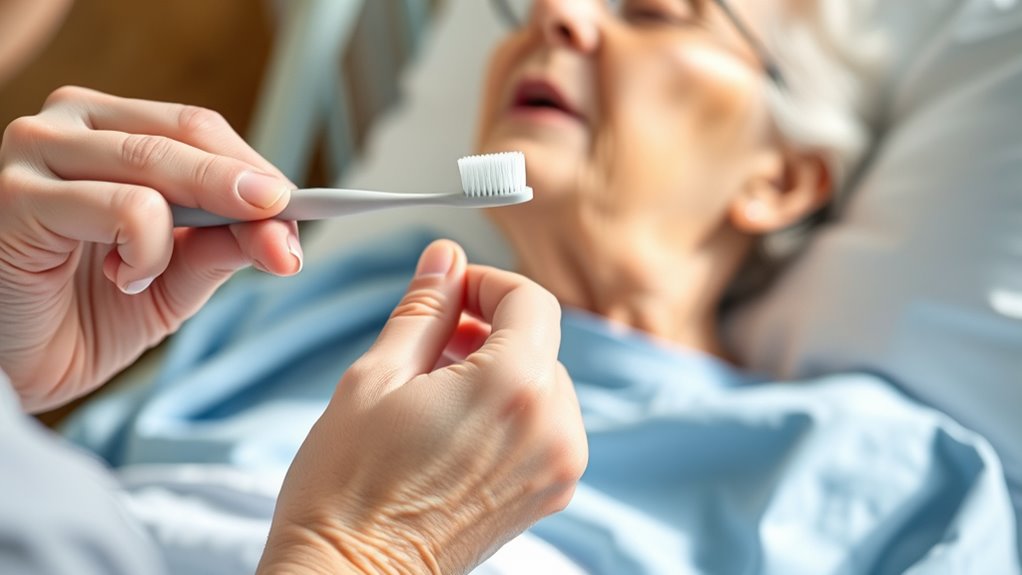
Selecting the right oral care products is essential for effectively maintaining the oral health of bed-bound Alzheimer’s patients. Choose gentle, fluoride-containing toothpaste to protect against decay without causing discomfort. Soft-bristled toothbrushes are best—they clean effectively while being gentle on gums. Consider using alcohol-free mouth rinses to reduce dryness and irritation. Here’s a quick reference:
| Product Type | Key Features | Tips |
|---|---|---|
| Toothpaste | Fluoride, mild flavor | Use a small amount, gentle brushing |
| Toothbrush | Soft bristles, small head | Replace every 3 months |
| Mouth Rinse | Alcohol-free, moisturizing | Use sparingly; avoid harsh ingredients |
Regularly observing proper oral hygiene practices is vital in preventing infections and maintaining overall health. Additionally, regularly consulting with dental professionals can help tailor the best care plan for individual needs. Incorporating professional dental guidance ensures that specific challenges faced by Alzheimer’s patients are appropriately addressed, especially when considering specialized oral care protocols tailored to their unique needs. Recognizing the importance of comprehensive oral care in this context helps improve patient comfort and health outcomes.
Techniques for Gentle Tooth and Gum Cleaning
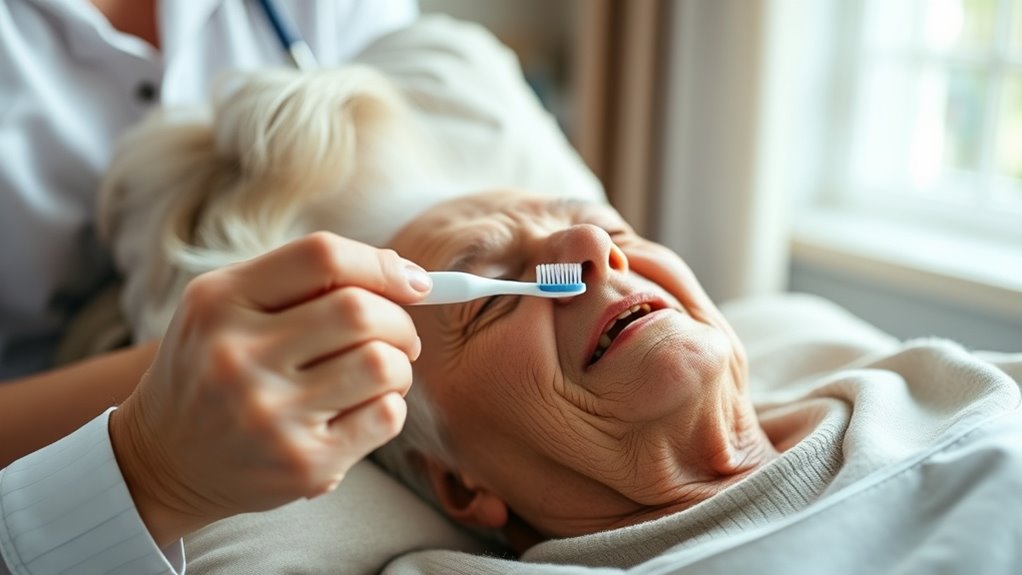
Using soft bristle tools helps prevent irritation and makes cleaning more comfortable. You should use gentle, circular motions when brushing your loved one’s teeth and gums. Moistening the gums beforehand can also reduce discomfort and improve overall effectiveness. Incorporating oral hygiene routines tailored for sensitive conditions can further enhance comfort during cleaning. Ensuring proper technique can maximize cleaning efficiency while minimizing discomfort. Additionally, selecting products with appropriate glycolic acid concentrations can help in maintaining healthy skin around the mouth area. Regularly monitoring oral health status can help detect issues early and improve overall care. Following a consistent tanning schedule can also promote healthier skin and reduce the risk of overexposure.
Soft Bristle Tools
Soft bristle tools are essential for gentle tooth and gum cleaning in bed-bound Alzheimer’s patients, as they minimize discomfort and reduce the risk of injury. These brushes are designed to be gentle on sensitive gums and delicate oral tissues, helping prevent irritation and bleeding. When selecting a tool, look for toothbrushes with soft, rounded bristles that can effectively clean without applying too much pressure. Electric toothbrushes with soft bristle heads can also be beneficial, providing consistent, gentle cleaning motions. Confirm the brush head fits comfortably in the patient’s mouth and reaches all areas easily. Regularly replace the toothbrush to maintain ideal cleaning efficiency and hygiene. Using soft bristle tools helps make oral care safer and more comfortable for patients with limited ability to cooperate or tolerate vigorous brushing.
Gentle Brushing Techniques
To guarantee gentle tooth and gum cleaning for bed-bound Alzheimer’s patients, it’s important to use techniques that minimize discomfort and prevent tissue damage. Start by supporting their head and ensuring they are comfortable. Use a small amount of soft-bristled toothbrush or finger brush, and gently hold their mouth open. Use slow, circular motions to clean each tooth and along the gumline, avoiding excessive pressure. Be mindful of sensitive areas, and don’t rush; patience is key. If resistance occurs, pause and reassure the patient. Always check for signs of discomfort and adjust your technique accordingly. Remember, the goal is to clean thoroughly while ensuring the patient feels safe and relaxed. Consistent, gentle movements help prevent injury and promote a positive oral care experience.
Moistening the Gums
After ensuring that the patient’s teeth are gently cleaned, it’s important to moisten the gums to promote comfort and prevent irritation. Use a clean, damp soft cloth or gauze to gently wipe along the gum line, ensuring the gums stay moist and healthy. You can also apply a small amount of water or a water-based oral moisturizer with a clean finger or swab, taking care not to cause discomfort. Focus on gentle, circular motions to avoid damaging sensitive tissue. Regular moistening helps prevent dryness, which can lead to soreness or cracking. Pay attention to any signs of redness or irritation, and adjust your technique accordingly. Consistent, gentle moistening maintains oral comfort and supports overall gum health.
Managing Difficulties With Swallowing and Gag Reflex

You need to recognize when your patient has difficulty swallowing or a strong gag reflex. Using gentle techniques can help reduce discomfort and prevent choking. Implementing specific strategies can make oral care safer and more comfortable for your patient. Incorporating hydration and nourishment into your routine can also support overall oral health and comfort.
Recognizing Swallowing Challenges
Recognizing swallowing challenges in bed-bound Alzheimer’s patients is essential for preventing complications such as choking or aspiration pneumonia. Look for signs like coughing during eating or drinking, drooling, pocketing food, or difficulty managing saliva. Notice if your patient has a weak or delayed swallow, gagging, or refuses certain textures. These indicators point to potential issues that need attention before feeding.
| Signs of Swallowing Challenges | Actions to Take |
|---|---|
| Coughing or choking | Adjust food texture, consult a specialist |
| Drooling or pocketing | Use proper positioning, monitor closely |
| Gagging or refusal | Modify feeding techniques, seek guidance |
| Delayed swallowing | Observe closely, avoid rushed feedings |
Strategies to Reduce Gag Reflex
Managing a gag reflex in bed-bound Alzheimer’s patients requires specific strategies to make swallowing safer and more comfortable. First, start with small, manageable bites to prevent overwhelming the gag reflex. Second, encourage slow, deliberate swallowing to give your patient time to adjust. Third, try lightly stimulating the roof of the mouth with a soft object or tongue to desensitize the gag response over time. Fourth, maintain a calm environment to reduce anxiety, which can heighten gag sensitivity. Remember, patience is key—if your patient shows signs of discomfort, pause and reassess. These strategies help create a safer swallowing experience, minimizing gagging and promoting oral comfort for your patient.
Addressing Dry Mouth and Salivary Issues
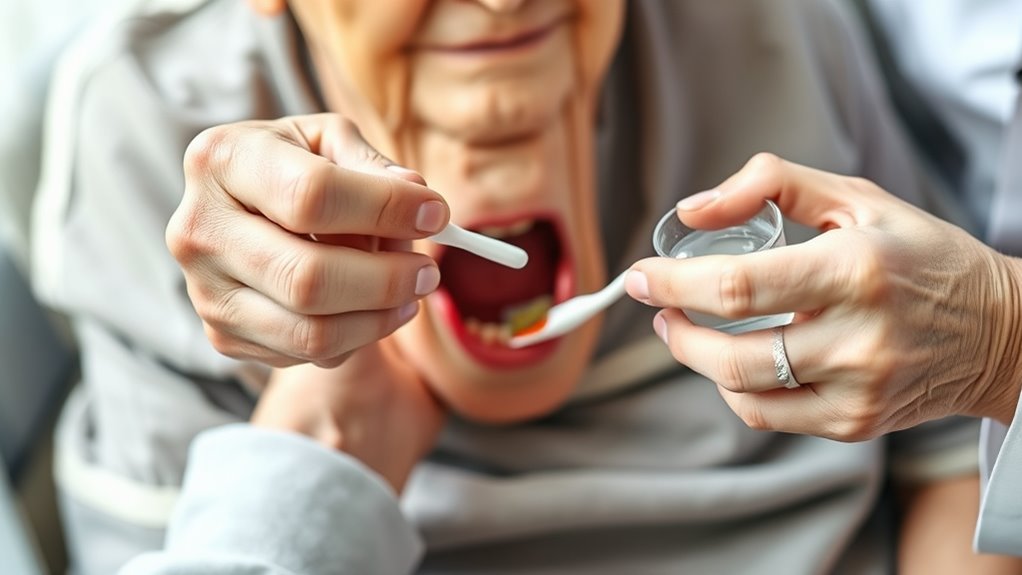
Dry mouth is a common issue among bed-bound Alzheimer’s patients, often resulting from medication side effects, dehydration, or the disease itself. To address this, encourage frequent sips of water or ice chips to keep the mouth moist. Using saliva substitutes or oral gels can provide temporary relief and improve comfort. Avoid sugary or acidic foods that can worsen dry mouth symptoms. Maintaining good hydration is essential; monitor fluid intake carefully. You can also gently moisten the lips with a water-based moisturizer or lip balm to prevent cracking. Regularly stimulating saliva production through gentle massaging of the salivary glands or encouraging chewing sugar-free gum (if tolerated) can help. Consistent attention to dry mouth promotes oral comfort and reduces the risk of complications.
Preventing and Detecting Oral Infections

You need to stay alert for early signs of oral infections, like redness, swelling, or sores. Proper hygiene is essential to prevent bacteria buildup that can lead to more serious issues. By regularly checking your loved one’s mouth and maintaining good oral care, you can catch problems early and keep infections at bay. Incorporating regular oral assessments can help identify issues before they worsen. Additionally, understanding how to recognize signs of infection can further aid in prompt intervention. Using effective oral care products can also help reduce the risk of bacterial accumulation and promote healing. Being aware of bacterial buildup and its role in infection development further emphasizes the importance of thorough oral hygiene.
Recognizing Early Signs
How can caregivers spot early signs of oral infections in bed-bound Alzheimer’s patients? Pay close attention to changes in their mouth that might indicate a problem. Look for these early signs:
- Redness or swelling in the gums
- Unusual bad breath or taste
- Signs of pain or discomfort when opening the mouth
- Any sores, ulcers, or white patches on the tongue or gums
These clues can signal infection or inflammation before they worsen. Regularly observe your patient’s mouth, even if they can’t communicate discomfort clearly. Noticing these early signs allows you to seek prompt treatment, preventing more serious issues. Staying vigilant helps maintain their oral health and overall well-being.
Ensuring Proper Hygiene
Maintaining proper oral hygiene is vital for preventing infections in bed-bound Alzheimer’s patients. You should clean their mouth regularly to remove food debris and plaque, which can harbor bacteria. Use a soft toothbrush or sponge applicator and gentle strokes to avoid causing discomfort. Pay special attention to the gums, tongue, and inside of the cheeks. Make certain their mouth stays moist by offering water or oral lubricants if they can swallow safely. Regular inspection is indispensable for early detection of issues like redness, swelling, or sores. Promptly address any signs of infection, such as bad odor or pus, to prevent complications. Consistent, gentle care keeps the mouth healthy and reduces the risk of serious infections that can worsen their overall health.
Ensuring Comfort and Minimizing Discomfort

To guarantee comfort and minimize discomfort during oral care for bed-bound Alzheimer’s patients, it’s essential to approach each task with sensitivity and patience. Your gentle touch and calm demeanor help ease anxiety and make the process smoother. Use soft, soothing movements, and speak softly to reassure them. Keep their head elevated to prevent gagging and ensure they’re relaxed. Paying attention to their cues—if they seem distressed, pause and try again later—can prevent unnecessary agitation. Building trust is key to reducing resistance. Additionally, being mindful of potential AI-driven safety concerns can help ensure a secure environment during care procedures. Incorporating compassionate communication can also foster a sense of safety and cooperation during oral care routines. Understanding portable medical devices and their proper use can further enhance the safety and comfort of the patient during routine care. Moreover, scheduling care during off-peak hours can help create a calmer environment conducive to cooperation. Recognizing the importance of cultural sensitivities can also improve patient comfort and compliance during oral care.
Educating and Supporting Caregivers and Family Members
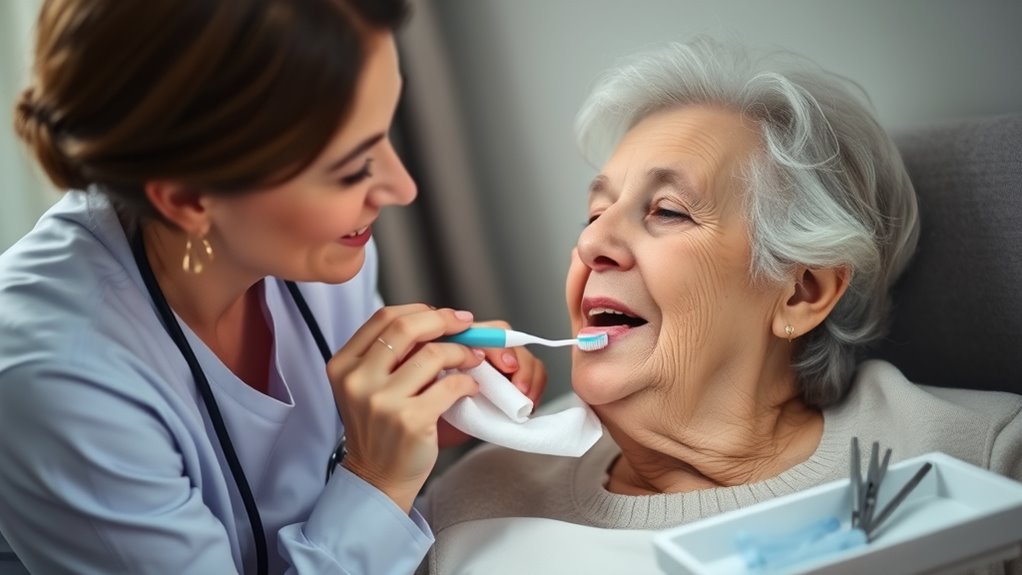
Educating and supporting caregivers and family members is essential to ensuring consistent and effective oral care for bed-bound Alzheimer’s patients. When you understand proper techniques and the importance of oral hygiene, you can better address your loved one’s needs. Provide clear instructions on brushing, flossing, and recognizing signs of oral health issues. Offer resources like instructional videos or printed guides to reinforce your training. Emotional support is equally important—caregiving can be stressful, so acknowledge your efforts and encourage open communication. Connecting with support groups or caregiver networks can help you share experiences and gain advice. Staying informed and confident in your role makes it easier to maintain your loved one’s oral health, reducing discomfort and preventing complications.
Collaborating With Dental Professionals for Ongoing Care

Since ongoing dental care is essential for preventing complications in bed-bound Alzheimer’s patients, working closely with dental professionals guarantees they receive appropriate, regular evaluations. Building this partnership helps you stay ahead of issues like infections or decay. To maximize care:
- Schedule routine dental check-ups and cleanings.
- Share updates about your patient’s oral health and any concerns.
- Follow professional advice on oral hygiene techniques and products.
- Arrange emergency consultations for sudden problems or pain.
Frequently Asked Questions
How Can I Tell if My Loved One Has Oral Pain or Discomfort?
You might notice your loved one showing signs of oral pain or discomfort through changes in behavior, like increased agitation, refusing to eat or drink, or avoiding talking or opening their mouth. Look for physical signs such as redness, swelling, sores, or bad breath. You can gently check their mouth if possible, but always be gentle and cautious, and consult a healthcare professional if you’re unsure or notice concerning symptoms.
What Are Signs of Oral Infections in Bed-Bound Alzheimer’S Patients?
Imagine noticing a sudden foul smell or your loved one avoiding eating or drinking. These signs might point to an oral infection. You could also see swollen gums, redness, or pus, along with increased drooling or bleeding when brushing. Watch for discomfort during mouth care, changes in facial expressions, or fussiness. These clues help you catch infections early, so you can seek prompt treatment and keep their mouth healthy.
How Often Should Dental Check-Ups Be Scheduled for These Patients?
You should schedule dental check-ups for bed-bound Alzheimer’s patients every six months. Regular visits help catch issues early, especially since they might not communicate discomfort clearly. Consistent dental care preserves oral health, prevents infections, and maintains comfort. If you notice any oral changes or problems, increase the frequency temporarily. Working with a dental professional guarantees these patients receive tailored, effective care to support their overall health.
Are There Specific Dietary Considerations to Improve Oral Health?
Oh, the joys of debating diet—because apparently, what you eat can turn your teeth into a fortress or a battlefield. You should prioritize nutrient-rich foods like fruits, vegetables, and dairy, which strengthen enamel and gums. Limit sugary snacks and acidic drinks that erode tooth structure. For bed-bound Alzheimer’s patients, consider softer, easy-to-chew options and make certain of hydration, because a well-nourished mouth is a happy mouth, after all.
How Can I Manage Bleeding Gums During Oral Care Routines?
When managing bleeding gums during oral care, you should be gentle and avoid harsh brushing. Use a soft-bristled toothbrush and gentle strokes to clean the gums and teeth. If bleeding persists, apply gentle pressure with a clean cloth or gauze to stop the bleeding. It’s also important to encourage regular flossing and maintain good oral hygiene. If bleeding continues, consult a dental professional for further assessment and treatment.
Conclusion
By following these oral care protocols, you can markedly improve your loved one’s comfort and health. For example, regularly checking for signs of infection helped a caregiver catch early gum issues, preventing pain and more serious problems. Remember, gentle, consistent care and open communication with dental professionals make a real difference. Your efforts not only maintain oral health but also enhance your loved one’s overall quality of life, showing your compassion and dedication every step of the way.
